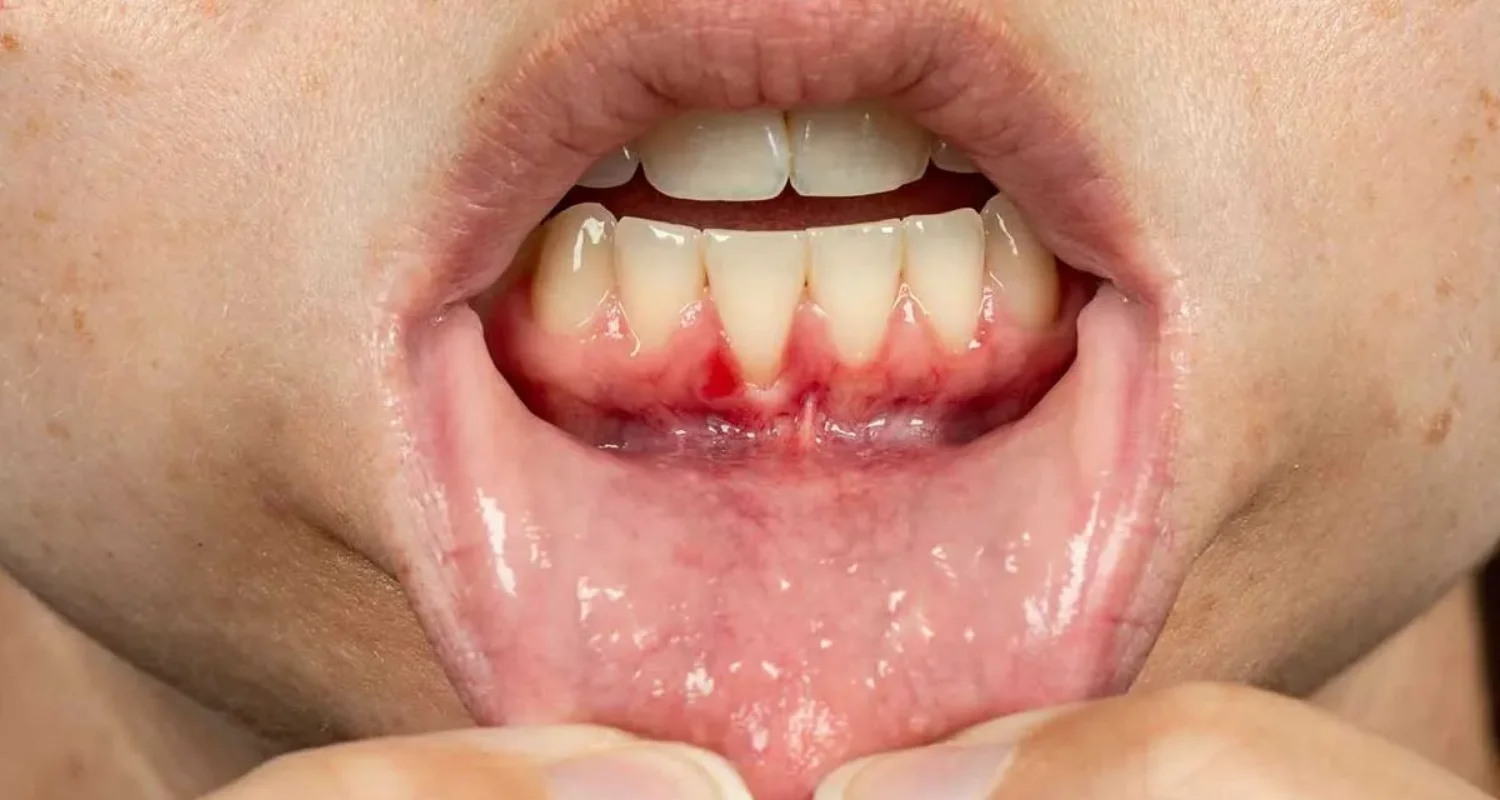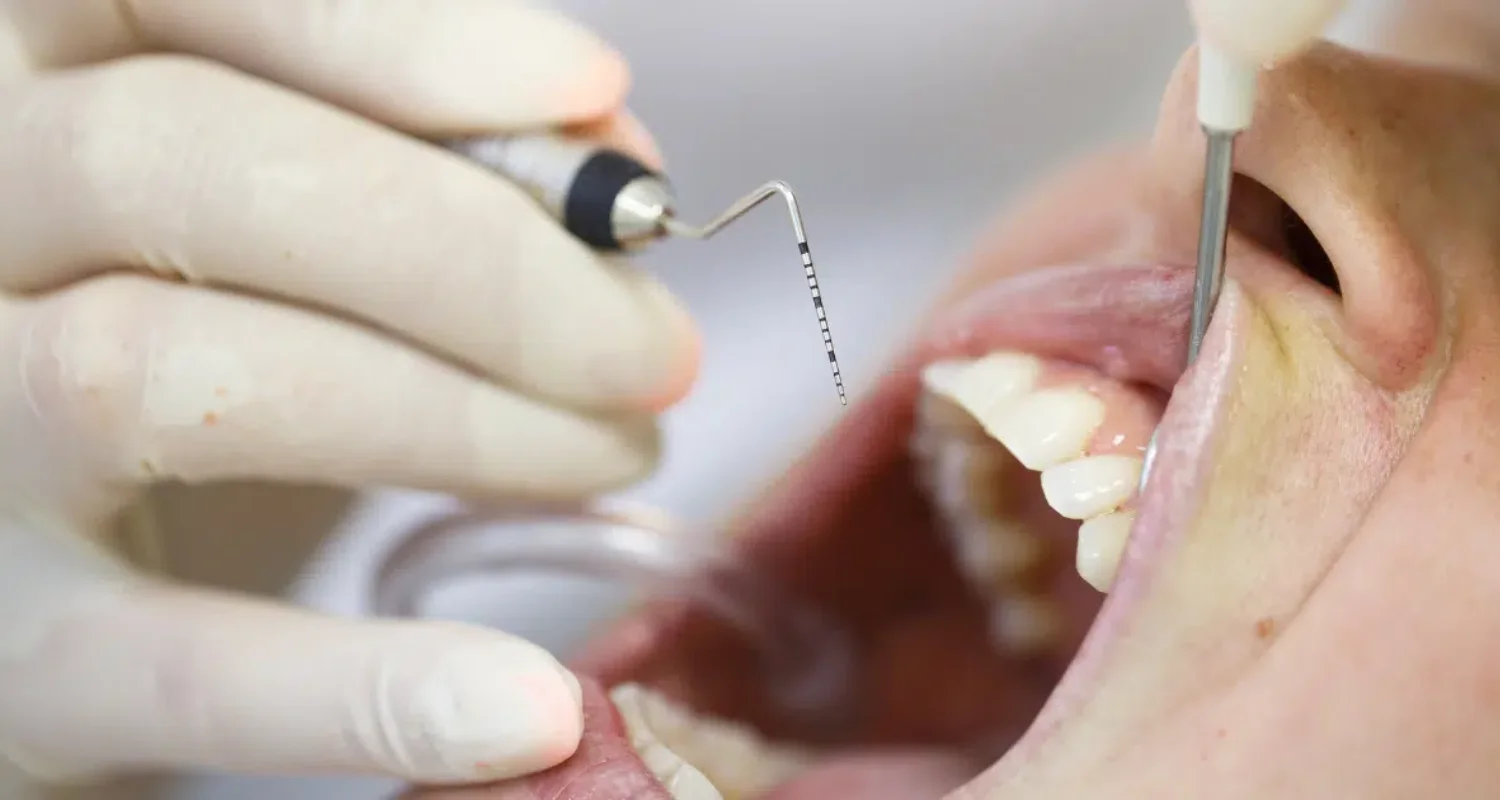Last Updated on: 19th September 2025, 12:36 pm
Periodontitis and rheumatoid arthritis are linked through chronic inflammation affecting both gums and joints. Managing gum disease can reduce systemic inflammation, easing rheumatoid arthritis symptoms and improving overall quality of life.
Periodontitis and rheumatoid arthritis (RA) are two chronic inflammatory conditions that profoundly impact oral and joint health. While they manifest in different areas of the body, recent research has highlighted a compelling connection between these seemingly unrelated diseases. Both share common inflammatory pathways, genetic predispositions, and lifestyle risk factors. Understanding this link can shed light on the importance of holistic health management, addressing oral health to potentially mitigate joint inflammation and vice versa.
This article will explore the relationship between periodontitis and rheumatoid arthritis, delving into shared causes, overlapping symptoms, and the implications of managing one condition to benefit the other.
What Do Periodontitis and Rheumatoid Arthritis Have in Common?
What is periodontitis?
Periodontitis is a severe gum disease that begins as gingivitis, a mild inflammation caused by plaque buildup on the teeth. If untreated, it progresses into an advanced stage where the infection damages the gums, bone, and connective tissues that support teeth. Key symptoms of periodontitis include:
- Persistent bad breath.
- Red, swollen, or bleeding gums.
- Gum recession that exposes tooth roots.
- Loose or shifting teeth.
Periodontitis is one of the main causes of tooth loss worldwide, affecting not just dental health but also the overall well-being of individuals. While bacterial infections are the primary drivers of the disease, factors such as inadequate oral care, smoking, and genetic predisposition can worsen its effects.
At its core, periodontitis is characterized by long-term inflammation caused by the immune system’s reaction to harmful bacteria in the gums. This inflammation damages the surrounding oral tissues and releases inflammatory substances into the bloodstream, which can lead to broader health complications beyond the mouth.
What is Rheumatoid Arthritis?
Rheumatoid arthritis is a systemic autoimmune disorder where the immune system mistakenly attacks the synovial lining of joints, leading to inflammation, pain, and progressive joint deformity. This disease affects approximately 1% of the global population.
Unlike osteoarthritis, which results from wear and tear, RA involves an immune-mediated process that can affect multiple organ systems. Some symptoms of RA include:
- Symmetrical joint pain and swelling, particularly in the hands, wrists, and feet.
- Morning stiffness lasted over an hour.
- Fatigue, low-grade fever, and weight loss.
- Deformities in advanced stages, such as swan neck or boutonniere deformities.
RA’s systemic nature means that it doesn’t only affect joints; it can lead to cardiovascular complications, lung disease, and even increased risk of infections.
How Are Periodontitis and Rheumatoid Arthritis Connected?
Periodontitis and rheumatoid arthritis (RA) are closely connected through shared mechanisms and risk factors, with chronic inflammation serving as the central link. RA patients are at greater risk of developing periodontitis due to a weakened immune system and medications like corticosteroids that can harm oral tissues. On the other hand, periodontitis can worsen RA symptoms by contributing to systemic inflammation, which exacerbates joint pain and stiffness.
This connection is influenced by several key factors:
- Systemic inflammation: Both RA and periodontitis involve the release of pro-inflammatory molecules such as tumor necrosis factor-alpha (TNF-α) and interleukin-6 (IL-6). These substances travel through the bloodstream, creating a feedback loop that damages joints in RA and the supporting tissues of teeth in periodontitis.
- Oral bacteria: The bacterium Porphyromonas gingivalis, commonly linked to periodontitis, may play a role in RA by altering proteins in the body. This process can trigger the formation of autoantibodies, a hallmark of RA, and the presence of P. gingivalis in joints suggests it may directly influence disease progression.
- Genetic overlap: Genetic predispositions, such as variations in the HLA-DR4 and HLA-DR1 genes, increase susceptibility to both conditions. These genes regulate immune responses, making some individuals more prone to chronic inflammation and, consequently, both RA and periodontitis.
- Lifestyle factors: Smoking, poor diet, and stress further connect these diseases. Smoking impairs immune function and worsens inflammation in both conditions. Diets high in processed foods promote systemic inflammation, while stress suppresses immune responses, increasing vulnerability to both diseases.
Addressing these shared factors with an integrated treatment approach can help reduce inflammation, improve symptoms, and enhance overall health. Combining periodontal care with RA management while encouraging a healthier lifestyle is essential for mitigating the impact of these interconnected conditions.
How managing Periodontitis may improve Rheumatoid Arthritis symptoms?
The intricate connection between periodontitis and rheumatoid arthritis lies in their shared inflammatory pathways. Research has shown that effective management of gum disease can significantly reduce systemic inflammation, which is a key factor in RA progression. By addressing periodontitis, patients may experience improvements in both oral health and RA symptoms, highlighting the importance of a multidisciplinary approach to healthcare.
Reduction in systemic inflammation
Periodontitis causes an immune response in the gums, releasing inflammatory molecules like TNF-α, IL-6, and IL-1β. These molecules can travel through the bloodstream, increasing overall inflammation and worsening rheumatoid arthritis (RA) symptoms, such as joint pain and stiffness. Treating periodontitis helps reduce this inflammation, which can lead to:
- Less joint pain and stiffness.
- Better movement in affected joints.
- Lower levels of inflammation markers like C-reactive protein (CRP).
Studies show that treatments like deep cleanings (scaling and root planing) significantly reduce inflammation in the body, leading to improved RA symptoms and better disease management.
Specific interventions for managing periodontitis
Managing periodontitis effectively involves a mix of preventive and therapeutic treatments, which can help reduce inflammation and improve rheumatoid arthritis (RA) symptoms:
- Scaling and root planing (SRP): This deep-cleaning procedure removes plaque and tartar buildup beneath the gumline, targeting bacteria responsible for periodontal damage. SRP helps reduce inflammation both locally in the gums and systemically, benefiting RA patients by alleviating joint symptoms.
- Laser therapy: Advanced periodontal treatments using lasers can precisely target inflamed tissues and harmful bacteria while minimizing damage to surrounding healthy areas. Laser therapy accelerates healing, making it particularly beneficial for patients who may struggle with traditional surgical methods due to RA-related joint limitations.
- Antimicrobial therapy: Topical or systemic antibiotics, such as doxycycline, are often used alongside other treatments to combat bacterial infections. These medications not only reduce the bacterial load in the gums but also indirectly influence systemic inflammation, providing dual benefits for patients with RA.
- Adjunctive anti-inflammatory agents: Local anti-inflammatory agents, like corticosteroid gels or nonsteroidal anti-inflammatory drugs (NSAIDs), can soothe gum tissues and decrease the release of pro-inflammatory molecules. These treatments work well alongside systemic RA medications.
- At-home oral hygiene: Daily brushing, flossing, and using antibacterial mouthwash help control oral bacteria and reduce gum inflammation. Maintaining good oral hygiene prevents periodontal disease from worsening and limits systemic effects.
Medications and holistic care
Many treatments for periodontitis align with RA management strategies, creating an opportunity for holistic care. Anti-inflammatory medications commonly used for RA, such as non-steroidal anti-inflammatory drugs (NSAIDs) or corticosteroids, can also help control gum inflammation. Conversely, periodontal therapies can make systemic RA treatments more effective by reducing the inflammatory load.
- NSAIDs: These medications alleviate pain and inflammation in both conditions. Patients receiving periodontal treatments may find that their NSAID requirements decrease over time as systemic inflammation subsides.
- Corticosteroids: Used for severe RA cases, corticosteroids can also reduce acute gum inflammation. However, long-term use may have side effects like delayed wound healing, making periodontal maintenance crucial.
Treating periodontitis in patients with rheumatoid arthritis (RA) not only reduces systemic inflammation, alleviating joint pain and improving mobility, but it can also decrease the need for anti-inflammatory medications. This highlights the importance of including periodontal care as a key part of RA management.
Beyond clinical benefits, addressing periodontitis significantly improves patients’ quality of life. By reducing pain, swelling, and fatigue caused by chronic inflammation, patients can regain their ability to perform daily activities with greater comfort, confidence, and overall well-being.
What Symptoms Do Periodontitis and RA Have in Common?
Periodontitis and rheumatoid arthritis (RA) share several overlapping symptoms due to their inflammatory nature:
- Chronic pain: Inflammation in the gums and joints causes ongoing discomfort, interfering with everyday activities such as eating and walking.
- Fatigue: Systemic inflammation leads to low energy levels and difficulty concentrating, impacting productivity and overall well-being.
- Swelling: Visible swelling in both gums and joints signals active inflammation, contributing to pain and reduced functionality.
How Periodontitis and Rheumatoid Arthritis affect quality of life
If untreated, periodontitis and RA can greatly diminish quality of life:
- Functional limitations: Gum disease can make chewing and speaking painful, while joint damage from RA reduces mobility and independence.
- Emotional impact: Chronic pain, physical limitations, and visible symptoms like swollen gums or joint deformities can lead to emotional distress, anxiety, and reduced self-confidence.
Can Managing Gum Disease Improve Life with RA?
Effectively managing periodontitis not only helps alleviate RA symptoms and also significantly enhances overall well-being:
- Restored oral function: Treating gum disease eases pain, swelling, and bleeding, making it easier to eat, speak, and maintain oral hygiene.
- Nutritional benefits: Improved oral health allows for a balanced diet, which supports joint health and overall systemic well-being.
- Enhanced social confidence: Addressing issues like bad breath (halitosis) or visible gum problems helps patients engage in social activities without embarrassment.
- Reduced stress: Improved oral health can boost self-confidence and lower anxiety levels, which in turn reduces inflammation and benefits both periodontitis and RA.
By treating periodontitis, patients experience a dual benefit: reduced systemic inflammation and improved day-to-day comfort, enabling them to live healthier, more fulfilling lives.
Should RA Patients Include Dentists in Their Care Team?
The bidirectional relationship between periodontitis and RA emphasizes the need for a collaborative approach to treatment. Dentists, rheumatologists, and primary care physicians must work together to develop comprehensive care plans. For example:
- Coordinated monitoring: Regular communication between healthcare providers ensures that improvements in one condition are reflected in the management of the other.
- Customized treatment plans: Tailored therapies that consider the patient’s RA medication regimen, lifestyle factors, and oral hygiene habits yield better outcomes.
- Patient education: Empowering patients with knowledge about the link between gum and joint health encourages proactive care, such as maintaining oral hygiene and attending regular dental checkups.
Why regular checkups are essential for patients with RA
Proactive dental care: Routine dental visits are crucial for early detection and management of gum disease. RA patients should inform their dentists of their condition to receive tailored care, focusing on minimizing systemic inflammation.
Collaborative care: Effective management requires collaboration between dentists, rheumatologists, and primary care providers. For example, a dentist may recommend specific periodontal treatments that align with the patient’s RA medication regimen.
The effects of nonsurgical periodontal therapies on RA
Several studies highlight the benefits of nonsurgical periodontal therapies for RA patients:
- Reduction in inflammatory markers: Scaling and root planing can lower CRP and TNF-α levels.
- Improved disease activity scores: Patients report reduced joint pain and swelling post-treatment.
- Lowered erythrocyte sedimentation rates (ESR): Indicating decreased systemic inflammation.
These findings emphasize the importance of integrating dental care into RA management plans.
What Research Links Periodontitis and RA Relief?
Several studies have highlighted the positive impact of managing periodontitis on RA symptoms. For instance:
1. A clinical trial published in Arthritis and Rheumatology found that patients undergoing nonsurgical periodontal therapy experienced reduced levels of CRP and TNF-α, along with improved Disease Activity Scores (DAS28) for RA.
2. A 2018 meta-analysis revealed that deep cleaning procedures led to significant reductions in markers of systemic inflammation, suggesting that periodontal care can indirectly benefit RA management.
3. Longitudinal studies have shown that RA patients who maintain good oral health report fewer disease flare-ups and improved physical function over time.
The connection between periodontitis and rheumatoid arthritis (RA) highlights how inflammatory diseases can influence each other, emphasizing the importance of a holistic approach to health. Treating gum disease not only reduces systemic inflammation but also alleviates joint pain and improves overall quality of life for RA patients. Regular dental checkups, consistent oral hygiene, and collaborative care between dentists and healthcare providers are essential to addressing these intertwined conditions effectively.
Emerging research is paving the way for innovative treatments, such as medications targeting shared inflammatory pathways and oral probiotics to balance the microbiome. These advancements promise to enhance both oral and systemic health. By recognizing the interdependence of oral and overall wellness, patients with RA can achieve better outcomes, enjoying improved mobility, reduced pain, and a higher quality of life. This integrated approach underscores the fact that addressing gum health is about far more than preserving teeth; it’s about fostering overall well-being.
Frequently Asked Questions
What signs of periodontitis should RA patients look out for?
RA patients should monitor for red, swollen, or bleeding gums, persistent bad breath, gum recession, tooth sensitivity, and loosening of teeth. Early detection is key to preventing complications.
Is periodontitis reversible in RA patients?
In its early stages (gingivitis), periodontitis can often be reversed with professional treatment and improved oral hygiene. However, advanced periodontitis may require more intensive therapy to manage the condition and prevent further damage.
How do hormonal changes affect periodontitis and rheumatoid arthritis?
Hormonal fluctuations, such as during pregnancy or menopause, can exacerbate inflammation and worsen symptoms in both conditions. Proper care during these periods is essential.
How can family history influence periodontitis and rheumatoid arthritis?
A family history of RA or severe gum disease may indicate a genetic predisposition, increasing the likelihood of developing one or both conditions.
Are RA patients with dental implants at higher risk for complications?
Yes, RA patients may be at a higher risk for implant complications due to slower healing and higher inflammation levels. Regular dental monitoring is essential for implant maintenance.
Voice and Search (Q&A)
Can treating gum disease help with rheumatoid arthritis symptoms?
Yes, treating periodontitis can reduce systemic inflammation, which may lead to fewer RA flare-ups, less joint pain, and improved mobility.
Why are people with rheumatoid arthritis more likely to develop periodontitis?
RA weakens the immune system and often requires medications that affect oral health, making patients more vulnerable to gum infections and inflammation.
What dental treatments are recommended for RA patients with periodontitis?
Non-surgical therapies like scaling and root planing, laser treatments, and antimicrobial rinses are commonly used to manage gum disease and reduce RA-related inflammation.
Share
References
1. Benisek, A. (2024, 7 september). RA and Periodontal Disease: What’s the Link?. WebMD. https://www.webmd.com/rheumatoid-arthritis/rheumatoid-arthritis-periodontal-disease
2. Bingham, C. O., & Moni, M. (2013, may). Periodontal disease and rheumatoid arthritis. Current Opinion In Rheumatology, 25(3), 345-353. https://journals.lww.com/co-rheumatology/abstract/2013/05000/periodontal_disease_and_rheumatoid_arthritis__the.10.aspx
3. Darrah, E. (2017, 7 march). Gum disease linked to rheumatoid arthritis. Johns Hopkins Rheumatology. https://www.hopkinsrheumatology.org/2017/01/gum-disease-linked-to-rheumatoid-arthritis/
4. De Pablo, P., Chapple, I. L. C., Buckley, C. D., & Dietrich, T. (2009, april). Periodontitis in systemic rheumatic diseases. Nature Reviews Rheumatology, 5(4), 218-224. https://doi.org/10.1038/nrrheum.2009.28
5. Jajoo, N. S., Shelke, A. U., Bajaj, R. S., & Devani, V. (2020, 9 august). Correction to: Periodontitis and Rheumatoid Arthritis: The Common Thread. Clinical Reviews In Bone And Mineral Metabolism, 19(1-4), 50-62. https://doi.org/10.1007/s12018-021-09280-z
5. Rodríguez-Lozano, B., González-Febles, J., Garnier-Rodríguez, J.L. (2019, 18 january). Association between severity of periodontitis and clinical activity in rheumatoid arthritis patients: a case–control study. Arthritis Res Ther 21, 27. https://doi.org/10.1186/s13075-019-1808-z
-
Dr. Yeidy Carolina Mesa [Author]
DDS Yeidy Carolina Mesa Passionate Dentist | Advocate for Accessible Oral Health Education Graduating from Universidad CES in 2022, I am a dedicated general dentist with a lifelong passion for helping others and making a meaningful impact in the world. My journey into dentistry began at the age of 7, inspired by my own experience with braces and overcoming a fear of the dentist. This personal journey shaped my mission to help patients conquer their own dental anxieties and embrace a healthier,...
View all posts






















